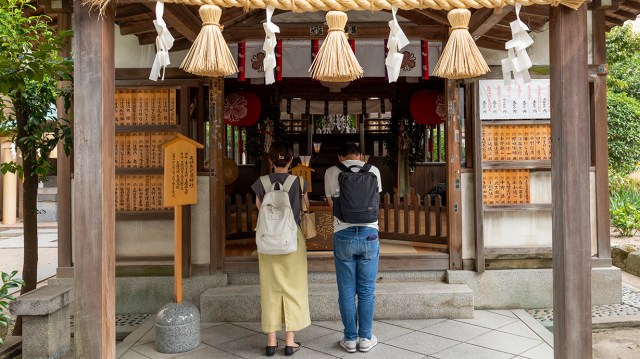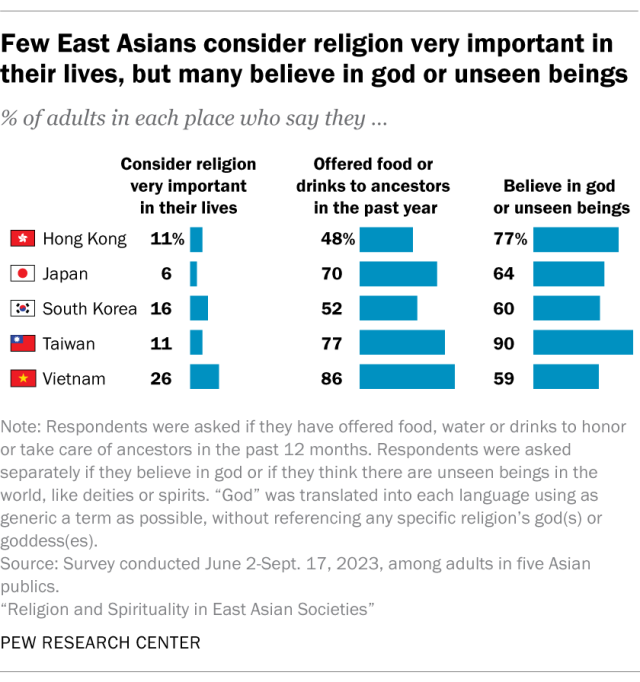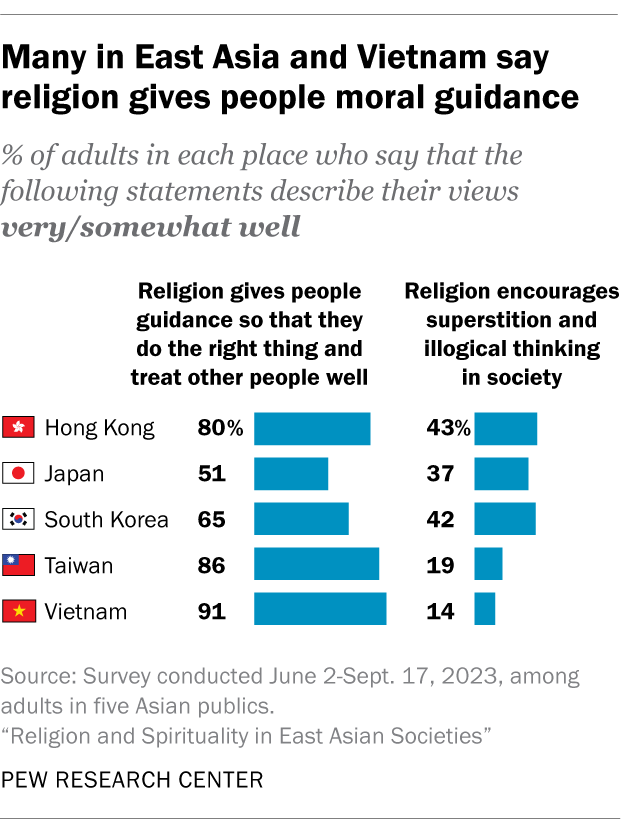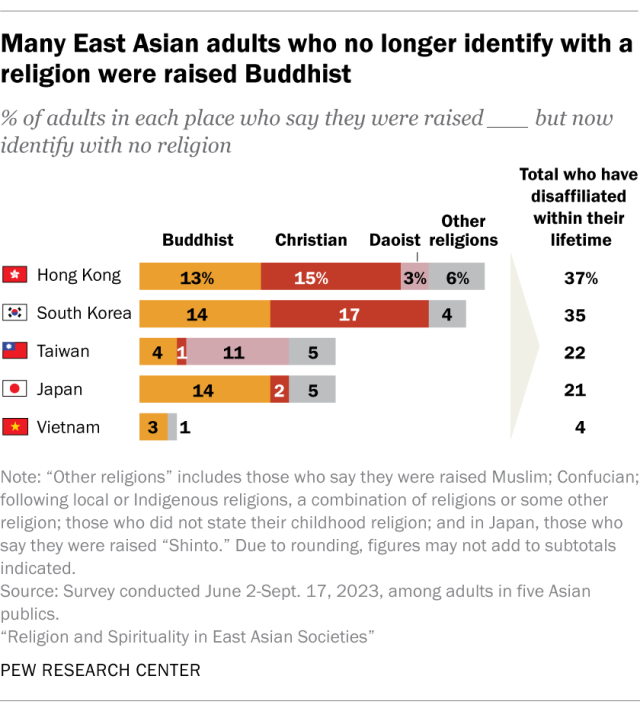
2023 年 8 月,人们在日本福冈的栉田神社祈祷。(Eric Lafforgue/Art in All of Us/Corbis via Getty Images)
Many adults in East Asia and neighboring Vietnam have no religious affiliation. By some measures, the region seems like one of the least religious in the world. Yet many people in the region – including the religiously unaffiliated – hold religious or spiritual beliefs and engage in traditional rituals.
东亚和邻国越南的许多成年人没有宗教信仰。从某些方面来看,该地区似乎是世界上宗教信仰最少的地区之一。然而,该地区的许多人 — — 包括无宗教信仰的人 — — 持有宗教或精神信仰并参与传统仪式。
These findings come from a 2023 Pew Research Center survey of more than 10,000 adults in Hong Kong, Japan, South Korea, Taiwan and Vietnam. This survey builds on previous Center studies on religion in China, India, and South and Southeast Asia.
这些发现来自皮尤研究中心 2023 年对香港、日本、韩国、台湾和越南 10,000 多名成年人进行的调查。这项调查建立在中心之前对中国、印度、南亚和东南亚宗教的研究的基础上。
Here are six key findings about religion and spirituality in East Asia and Vietnam.
以下是有关东亚和越南宗教和灵性的六项重要发现。
This analysis is drawn from the Pew Research Center report “Religion and Spirituality in East Asian Societies.” For that report, we surveyed 10,390 adults across East Asia and neighboring Vietnam. Local interviewers administered the survey in seven languages from June to September 2023.
Interviews were conducted over the phone in four places: Hong Kong, Japan, South Korea and Taiwan. In Vietnam, interviews took place face-to-face.
This survey is part of the Pew-Templeton Global Religious Futures project, which analyzes religious change and its impact on societies around the world.
Respondents were selected using a probability-based sample design. Data was weighted to account for different probabilities of selection and to align with demographic benchmarks for the adult population.
For more information, refer to the report’s methodology and the full survey questionnaire.
我们如何定义东亚
Typically, East Asia is considered to encompass China, Hong Kong, Japan, Macau, Mongolia, North Korea, South Korea and Taiwan. In geopolitical terms, Vietnam is often categorized as part of Southeast Asia. But we surveyed Vietnam along with East Asia for several reasons, including its historic ties to China and Confucian traditions. Moreover, Buddhists in Vietnam practice the same strain of Buddhism (Mahayana) found across East Asia.
Throughout this report, the term “East Asia” refers to Hong Kong, Japan, South Korea and Taiwan.
When discussing trends throughout the broader “region,” we include Vietnam.
For legal and logistical reasons, we did not survey several other places that are generally considered part of East Asia. At present, China does not allow non-Chinese organizations to conduct surveys on the mainland, and public opinion surveys are not possible in North Korea. Conducting nationally representative surveys in Mongolia is difficult due to the nomadic lifestyle of a large part of its people. We did not survey Macau because its population is relatively small.
Most people in the region say they either have no religion or identify as Buddhist. In three places surveyed, the religiously unaffiliated are the largest group. Roughly half or more adults in Hong Kong (61%), South Korea (52%) and Vietnam (48%) say they have no religion. Substantial shares in Japan (42%) and Taiwan (27%) say the same.
该地区的大多数人表示,他们要么没有宗教信仰,要么自认为是佛教徒。在接受调查的三个地方,无宗教信仰的人是最大的群体。在香港(61%)、韩国(52%)和越南(48%),大约一半或更多的成年人表示他们没有宗教信仰。日本(42%)和台湾(27%)的大部分人也有同样的说法。
Buddhism is also prevalent in the region: 46% of Japanese, 38% of Vietnamese and 28% of Taiwanese adults identify as Buddhist. In both South Korea and Hong Kong, 14% of adults are Buddhist.
佛教在该地区也很盛行:46% 的日本人、38% 的越南人和 28% 的台湾成年人认为自己是佛教徒。在韩国和香港,14%的成年人是佛教徒。
Substantial shares in South Korea and Hong Kong identify as Christian, and Taiwan has a sizable number of Daoists (also spelled Taoists).
韩国和香港有相当一部分人信仰基督教,而台湾则有相当数量的道教徒(也拼写为Taoists)。
Relatively few adults say religion is very important in their lives, but many hold spiritual beliefs. In the five places we surveyed, no more than 26% of adults say religion is very important in their lives. However, most adults say they believe in god or unseen beings, like deities or spirits.
相对较少的成年人表示宗教在他们的生活中非常重要,但许多人持有精神信仰。在我们调查的五个地方,不超过26%的成年人表示宗教在他们的生活中非常重要。然而,大多数成年人表示他们相信上帝或看不见的存在,例如神灵或灵魂。

Many people also view nature as having invisible spirits. In Taiwan, Japan and Vietnam, about half of adults or more say they believe that mountains, rivers or trees have their own spirits.
许多人还认为大自然有看不见的精灵。在台湾、日本和越南,大约一半或更多的成年人表示,他们相信山、河或树有自己的灵魂。
Religiously unaffiliated adults believe in god or unseen beings at lower rates than Christians and Buddhists do. However, at least four-in-ten unaffiliated adults in each place express these beliefs.
无宗教信仰的成年人相信上帝或看不见的存在的比例低于基督徒和佛教徒。然而,每个地方至少有十分之四的无党派成年人表达了这些信念。
Moreover, religiously unaffiliated people are generally more likely than Christians to believe that mountains, rivers or trees have their own spirits. For instance, in Hong Kong, 35% of unaffiliated adults say this, compared with 25% of Christians.
此外,无宗教信仰的人通常比基督徒更有可能相信山、河或树有自己的灵魂。例如,在香港,35% 的无宗教信仰的成年人这么说,而基督徒的这一比例为 25%。
Large shares participate in ancestor veneration rituals. The spirits of ancestors are a common focus of rituals in East Asia and Vietnam. Roughly half of adults or more in all places we surveyed say they have offered food, water or drinks to honor or take care of their ancestors in the last year. This practice is common among Buddhists and people who do not identify with a religion.
许多人参加祭祖仪式。祖先的灵魂是东亚和越南仪式的共同焦点。在我们调查的所有地方,大约一半或更多的成年人表示,他们在去年提供了食物、水或饮料来纪念或照顾他们的祖先。这种做法在佛教徒和不认同宗教的人中很常见。
In addition, many adults in the region have burned incense, offered flowers or lit candles in the last year to take care of ancestors. These practices are most evident in Vietnam, where 96% of adults say they have burned incense and 90% have offered flowers or lit candles recently.
此外,该地区许多成年人在过去的一年里烧香、献花或点燃蜡烛来照顾祖先。这些做法在越南最为明显,96%的成年人表示他们最近烧过香,90%的人最近献过花或点燃了蜡烛。
Praying or offering respects to religious figures or deities is fairly common in the region. Relatively few people in East Asia and Vietnam pray daily. Daily prayer is more common in South Asia and Southeast Asia. But many East Asians and Vietnamese say they pray at least occasionally, and substantial shares also say they “pray or offer their respects” to religious figures or deities.
在该地区,向宗教人物或神灵祈祷或表示敬意是相当普遍的。东亚和越南每天祈祷的人相对较少。每日祈祷在南亚和东南亚更为常见。但许多东亚人和越南人表示,他们至少偶尔会祈祷,而且相当一部分人还表示,他们向宗教人物或神祇“祈祷或表达敬意”。
“Offering respects” is commonly understood in the region as an act of worship or veneration. It can take a variety of forms, including:
“致敬”在该地区通常被理解为一种崇拜或崇敬的行为。它可以采取多种形式,包括:
- Burning incense 烧香
- Offering food or drink
提供食物或饮料 - Making wishes to a deity
向神灵许愿 - Bowing one’s head 低下头
- Putting one’s hands together
双手合十
In each place except Japan, most Buddhists say they pray or offer their respects to Guanyin – a folk deity associated with compassion – and to Buddha. Almost all Christians say they pray or offer respects to Jesus. (The survey also asked about praying or offering respects to other religious figures, such as Guandi and Mazu.)
在除日本以外的每个地方,大多数佛教徒都表示他们向观音(一种与慈悲相关的民间神灵)和佛陀祈祷或致敬。几乎所有基督徒都说他们向耶稣祈祷或表示敬意。 (调查还询问了对其他宗教人物的祈祷或致敬,例如关帝和妈祖。)
People across the region generally view religion as a positive force in society. Majorities in Hong Kong, South Korea, Taiwan and Vietnam say that religion helps society by giving people guidance to do the right thing. In Japan, about half of adults take this position.
该地区人民普遍认为宗教是社会的积极力量。香港、韩国、台湾和越南的大多数人表示,宗教通过指导人们做正确的事来帮助社会。在日本,大约一半的成年人采取这种立场。

Across the region, Christians are somewhat more likely than other groups to see religion as a positive for society. In Hong Kong, for instance, 89% of Christians say religion guides people to do the right thing and treat others well, compared with 78% of Buddhists and 76% of the unaffiliated.
在整个地区,基督徒比其他群体更有可能将宗教视为对社会的积极影响。例如,在香港,89%的基督徒表示宗教引导人们做正确的事并善待他人,而佛教徒和无宗教人士的这一比例为78%和76%。
Negative views about religion’s role in society are not as widespread. Still, roughly four-in-ten each in Hong Kong, Japan and South Korea say religion encourages superstition and illogical thinking.
对宗教在社会中的作用的负面看法并不那么普遍。尽管如此,在香港、日本和韩国,大约十分之四的人表示宗教鼓励迷信和不合逻辑的思维。
In these places, the word “religion” is often understood to refer to organized, hierarchical forms of religion – such as Christianity or new religious movements – not to traditional Asian forms of spirituality. (“Religion” is commonly translated as zongjiao in Chinese, shūkyō in Japanese and jonggyo in Korean.)
在这些地方,“宗教”一词通常被理解为指有组织的、等级化的宗教形式——例如基督教或新宗教运动——而不是指传统的亚洲精神形式。 (“宗教”在中文中通常被翻译为“宗教”,在日语中被翻译为“shūkyō”,在韩语中被翻译为“jonggyo”。)
Religious identification in the region is changing dramatically. Many adults in East Asia and Vietnam have switched away from their religious upbringing to no religion or to some other religion. The shares of adults who say this range from 17% in Vietnam to 53% each in Hong Kong and South Korea.
该地区的宗教认同正在发生巨大变化。东亚和越南的许多成年人已经放弃了宗教教育,转而无宗教信仰或皈依其他宗教。说这句话的成年人比例从越南的 17% 到香港和韩国的 53% 不等。
Most of this switching is disaffiliation. In some East Asian places, more than three-in-ten adults say they were raised in a religion but now identify with none. These rates of religious disaffiliation are among the highest in the world. Disaffiliation is much less common in Vietnam.
这种转变大部分是脱离关系。在一些东亚地区,超过十分之三的成年人表示,他们是在某种宗教中长大的,但现在却不认同任何宗教。这些宗教脱离率是世界上最高的。在越南,脱离关系的情况要少得多。

The departures are mostly from Buddhism, Christianity and Daoism. For instance, 14% of South Korean and Japanese adults report that they were brought up Buddhist but no longer identify with any religion.
背离的主要是佛教、基督教和道教。例如,14% 的韩国和日本成年人表示,他们从小就信佛,但不再认同任何宗教。
Other adults in the region have switched from their childhood religion to another religion. For example, 12% of adults in South Korea and 9% in Hong Kong currently identify as Christian but were raised in a different religious tradition or with no religious identity.
该地区的其他成年人已经从儿时的宗教转向了另一种宗教。例如,韩国 12% 的成年人和香港 9% 的成年人目前认为自己是基督徒,但在不同的宗教传统中长大或没有宗教身份。
Note: For more information, refer to the report’s methodology and the full survey questionnaire.
注:欲了解更多信息,请参阅报告的方法论和完整的调查问卷。
